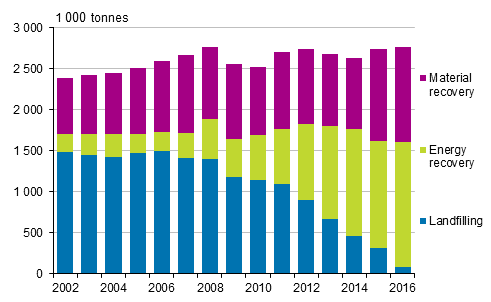Published: 15 January 2018
Recovery of waste has replaced disposal of municipal waste at landfill sites
Disposal of municipal waste at landfill sites has decreased strongly according to the development that has continued in recent years. In 2016, only around three per cent of municipal waste was disposed at landfill sites. It has been replaced by recovery of waste: both energy production and material recovery are competing for the recovery of former landfill waste, of which energy use of municipal waste has been the general treatment method in recent years.
Amount of municipal waste by treatment method in 2002 to 2016

Within a short time, municipal waste has become a significant energy fuel for district heat production of built-up areas. Biocomponents included in energy-recovered municipal waste, such as wood, paperboard and cardboard and food waste, also curb greenhouse gas emissions in case they replace the use of fossil fuels.
Amount of separately collected municipal waste growing
Although mixed waste and its recovery as energy are still generally discussed, separate collection arrangements have changed the quality and composition of mixed waste directed to energy recovery on the level of the whole country. Increasingly more waste components are directed to separate collection in place of mixed waste, such as collection of packaging waste in the scope of producer responsibility waste, and thus material recovery.
In 2016, around 97 per cent of municipal waste was recovered, which is a new record. The material recovery rate is high particularly for fibre packaging generated in service industries such as trade. Most of biowaste is composted or digested. Around two-thirds of the total amount of kitchen and food waste and garden waste are composted and one third digested. The digestion residue is used in soil improvement or landscaping, as is compost soil.
Total amount of municipal waste per inhabitant has stabilised
The amount of municipal waste has been 2.4 to 2.8 million tonnes per year in Finland after the turn of the millennium. Although the total amount of municipal waste has in recent years grown slightly in numerical value, the growth has been small, and calculated by inhabitant, the amount has stabilised to around five hundred kilograms per year in 2016. The growth in the total amount of municipal waste is thus explained by the rising number of inhabitants.
Source: Waste statistics 2016, Statistics Finland
Inquiries: Juha Espo 029 551 3463, Johanna Pakarinen 029-5513313, ymparistotilinpito@stat.fi
Director in charge: Ville Vertanen
Publication in pdf-format (199.9 kB)
- Tables
-
Tables in databases
Pick the data you need into tables, view the data as graphs, or download the data for your use.
Appendix tables
Updated 15.1.2018
Official Statistics of Finland (OSF):
Waste statistics [e-publication].
ISSN=2323-5314. Municipal waste 2016. Helsinki: Statistics Finland [referred: 20.4.2025].
Access method: http://stat.fi/til/jate/2016/13/jate_2016_13_2018-01-15_tie_001_en.html

